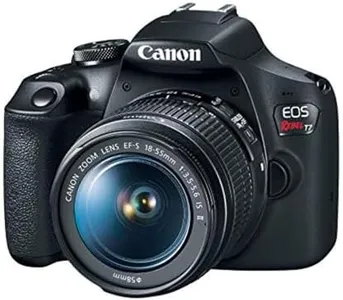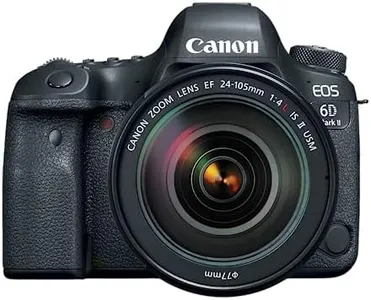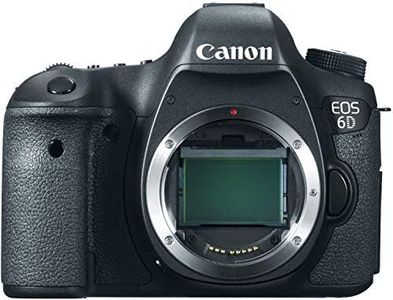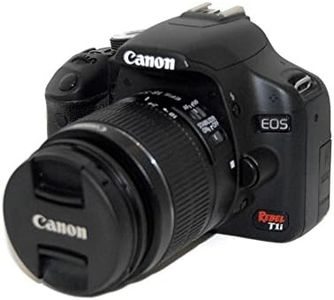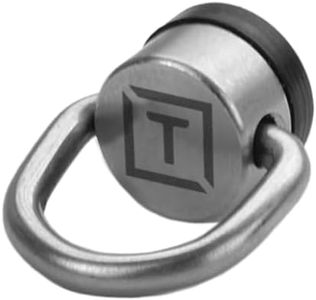6 Best Canon Affordable Dslrs 2025 in the United States
Our technology thoroughly searches through the online shopping world, reviewing hundreds of sites. We then process and analyze this information, updating in real-time to bring you the latest top-rated products. This way, you always get the best and most current options available.

Our Top Picks
Winner
Canon EOS Rebel T7 DSLR Camera with 18-55mm Lens | Built-in Wi-Fi | 24.1 MP CMOS Sensor | DIGIC 4+ Image Processor and Full HD Videos
Most important from
8242 reviews
The Canon EOS Rebel T7 is a solid entry-level DSLR, particularly suitable for beginners and hobbyists looking for an affordable option. It boasts a 24.1 MP APS-C CMOS sensor, which is excellent for capturing detailed images. The ISO range of 100-6400, expandable to 12800, allows for decent performance in various lighting conditions, although low-light performance might not be as robust as higher-end models.
The built-in Wi-Fi and NFC make it convenient for transferring images to other devices without needing cables. The 9-point autofocus system is basic but adequate for general photography needs, although it may struggle with fast-moving subjects. The continuous shooting speed of 3 fps is modest and may not be sufficient for high-speed action photography. Video capabilities of Full HD 1080p are good for casual video recording, though it lacks 4K resolution which might be a drawback for videography enthusiasts.
The build quality is solid with straightforward ergonomics, making it comfortable for extended shooting sessions. The included 18-55mm lens is versatile for various shooting scenarios, but investing in additional lenses may be necessary for specialized photography. The EOS Rebel T7 is compatible with Canon EF and EF-S lenses, providing ample options for future lens upgrades. In summary, the Canon EOS Rebel T7 is a capable and affordable DSLR, best suited for those new to photography or looking for a reliable camera for everyday use.
Most important from
8242 reviews
Canon EOS 6D Mark II DSLR Camera with EF 24-105mm USM Lens, WiFi Enabled Black
Most important from
1301 reviews
The Canon EOS 6D Mark II is a strong choice for photographers wanting an affordable full-frame DSLR. Its 26.2-megapixel sensor delivers sharp, high-quality images with good detail. The camera performs well in low light thanks to a wide ISO range that goes up to 40,000 (expandable to 102,400), helping you shoot in dim conditions without too much noise. Autofocus is reliable with 45 cross-type points, providing good accuracy whether you're shooting stills or using the Dual Pixel CMOS AF for smoother focus in live view and video.
Continuous shooting at 6.5 frames per second makes it decent for capturing action, though it’s not the fastest for sports photography. Video recording is solid with Full HD 1080p at 60fps, but it lacks 4K. The camera's build is comfortable, featuring a sturdy feel and a fully articulating 3-inch touchscreen, which is great for creative angles and easy menu navigation. Lens compatibility is broad, supporting all Canon EF lenses, including the included versatile 24-105mm f/4 zoom lens that balances wide-angle and telephoto needs well for everyday shooting.
One downside is the absence of in-body image stabilization; stabilization depends on the lens used, so for handheld shots, you may need a lens with optical stabilization. Also, while it offers many advanced features, it may feel a bit complex for total beginners. This DSLR is well suited to enthusiasts and semi-professionals who want full-frame quality and flexibility without a very high price tag.
Most important from
1301 reviews
Canon EOS 6D 20.1 MP CMOS Digital SLR Camera with 3.0-Inch LCD (Body Only)
Most important from
1084 reviews
The Canon EOS 6D is an affordable DSLR suitable for photography enthusiasts looking for a full-frame sensor. Its 20.2MP full-frame CMOS sensor delivers high-quality images with excellent detail and dynamic range. The camera's ISO range allows for good performance in various lighting conditions, especially in low light.
However, the autofocus system, with only 11 points, is somewhat limited compared to more advanced models, which may affect fast-moving subject tracking. The continuous shooting speed of 4.5 frames per second is acceptable but not ideal for high-speed action photography. For video enthusiasts, the 1080p HD recording capability with manual controls is a plus, enabling creative flexibility.
The build quality is sturdy, and the ergonomics are user-friendly, making it comfortable to handle during long shoots. Lens compatibility is excellent with the Canon EF mount, giving access to a wide range of lenses. The maximum shutter speed of 1/4000 seconds might limit capturing very fast action. The camera's relatively compact size and lightweight design (27.16 ounces) make it easy to carry around. It's a reliable choice for those wanting to step into the full-frame DSLR world without breaking the bank, but it might not satisfy professional needs for high-speed or advanced autofocus performance.
Most important from
1084 reviews
Buying Guide for the Best Canon Affordable Dslrs
Choosing the right DSLR camera can be a daunting task, especially if you're new to photography or looking for an affordable option. The key is to understand the specifications that matter most to your needs and how they impact your photography experience. By focusing on these key specs, you can make an informed decision and find a camera that fits your requirements perfectly.FAQ
Most Popular Categories Right Now
